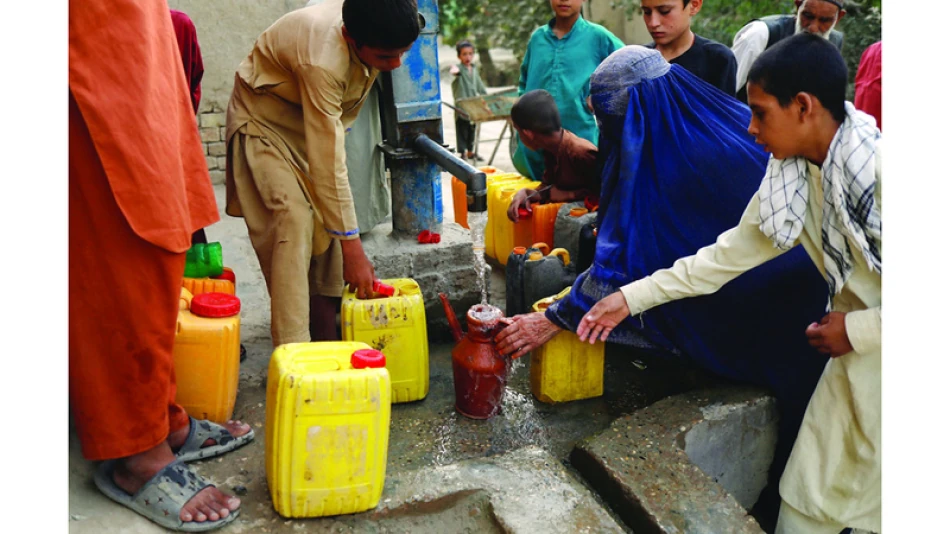
Kabul Faces Looming Water Crisis: Dire Predictions for Afghanistan's Capital
Kabul Faces Unprecedented Water Crisis That Could Make It First Modern Capital to Run Dry
Afghanistan's capital city stands on the brink of becoming the first major modern capital to completely exhaust its groundwater supplies, according to a new study by Mercy Corps. With aquifer levels dropping 25-30 meters over the past decade and consumption exceeding natural replenishment by 44 million cubic meters annually, Kabul's six million residents face an existential threat that no occupying army or local government has ever been able to address.
The Scale of Kabul's Water Emergency
The numbers paint a dire picture of resource depletion unprecedented in urban planning history. Kabul's groundwater levels have plummeted dramatically, with nearly half of the city's wells now completely dry. The remaining wells operate at just 60% efficiency, according to the UN Office for the Coordination of Humanitarian Affairs.
What makes this crisis particularly acute is the city's heavy dependence on groundwater—90% of Kabul's residents rely on well water for their daily needs, while only 20% of homes receive piped water from centralized sources. This dependency on a rapidly depleting resource creates a perfect storm for urban collapse.
Climate Change Accelerates the Crisis
The majority of Kabul's groundwater originates from snowmelt and ice from the Hindu Kush mountains, which feed the city's three main aquifers. However, climate change has fundamentally altered this natural replenishment system. Rising temperatures have increased evaporation rates while simultaneously boosting agricultural water consumption across the region.
Mohammed Mahmoud, CEO of the Climate and Water Initiative and head of climate and water policy for the Middle East at the UN University's Institute for Water, Environment and Health, explains that Kabul's climate challenge reflects a broader trend seen in water-scarce regions worldwide. "Declining and changing precipitation patterns limit freshwater production and groundwater recharge, while increasing the frequency and intensity of droughts," he told Live Science.
Urban Explosion Without Infrastructure Investment
Kabul's population has increased nearly six-fold over the past 25 years, but the city failed to develop adequate water management systems to handle this explosive growth. This demographic surge, combined with rapid industrial and residential development, has created unsustainable pressure on existing water resources.
The situation mirrors water crises in other rapidly growing cities like Chennai, India, or Cape Town, South Africa, but Kabul's predicament is uniquely severe due to its complete reliance on groundwater and lack of alternative sources.
Political Instability Derails Solutions
International donors had funded numerous dam projects and water management initiatives to address Kabul's water shortage, but most of these projects were abandoned or halted abruptly after 2021, when the United States withdrew from Afghanistan and the Taliban returned to power. This political transition effectively cut off the technical expertise and funding needed for large-scale infrastructure solutions.
The funding gap is staggering: only about $8 million of the required $264 million for water and sanitation projects has been provided, according to CNN's reporting on the closure of USAID programs under the Trump administration.
Contamination Compounds the Crisis
Even the remaining groundwater supplies face serious quality issues. Mercy Corps research indicates that approximately 80% of Kabul's groundwater is contaminated due to ineffective sewage systems and industrial waste. This contamination forces residents to seek water from even deeper sources or rely on expensive private companies.
Private water companies have emerged to exploit this crisis, extracting large quantities of public groundwater and reselling it to residents at inflated prices. Some families now spend up to 30% of their income on water, with more than two-thirds incurring water-related debt.
Market and Humanitarian Implications
From an economic perspective, Kabul's water crisis represents a catastrophic failure of urban resource management that could trigger massive population displacement. Unlike financial crises that can be resolved through policy changes, water depletion creates irreversible physical constraints on urban habitability.
The crisis also highlights the vulnerability of landlocked, mountainous regions to climate change impacts. Unlike coastal cities that can invest in desalination, or river cities with multiple water sources, Kabul's geographic constraints limit adaptation options.
Proposed Solutions Face Funding Reality
Mercy Corps proposes increased private sector cooperation as a potentially sustainable approach, focusing on regulation rather than direct service provision. The organization suggests that NGOs should concentrate on creating frameworks to ensure that any entity providing public water does so safely, effectively, and sustainably.
However, the most critical infrastructure projects remain severely underfunded and face significant planning obstacles. Without immediate coordinated investment, the report warns that Kabul risks becoming the first modern capital to experience comprehensive urban drought.
Learning from Global Water Management
Cities facing similar challenges, such as Mexico City or Jakarta, have implemented groundwater regulation, alternative source development, and demand management strategies. However, these solutions require stable governance, technical expertise, and substantial international cooperation—all currently limited in Afghanistan's political context.
The Kabul crisis serves as a stark warning for other rapidly growing cities in water-stressed regions. It demonstrates how quickly urban water security can collapse when population growth, climate change, and political instability converge without adequate long-term planning and investment in sustainable water infrastructure.
 Sara Khaled
Sara Khaled







